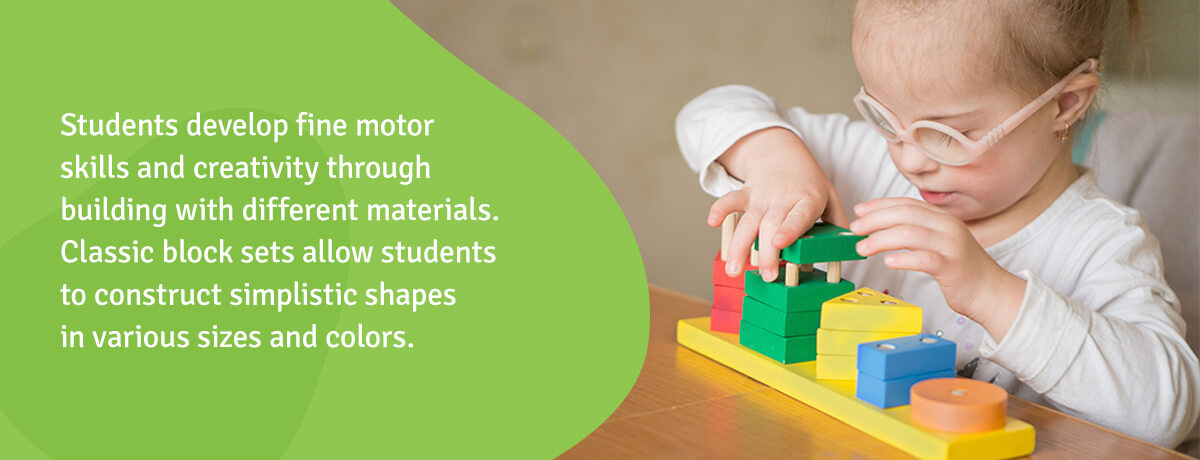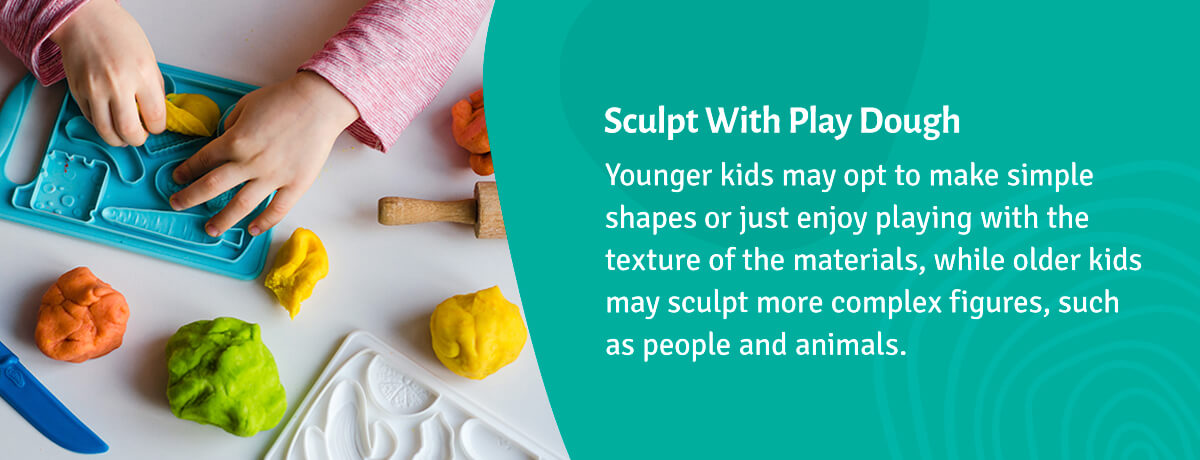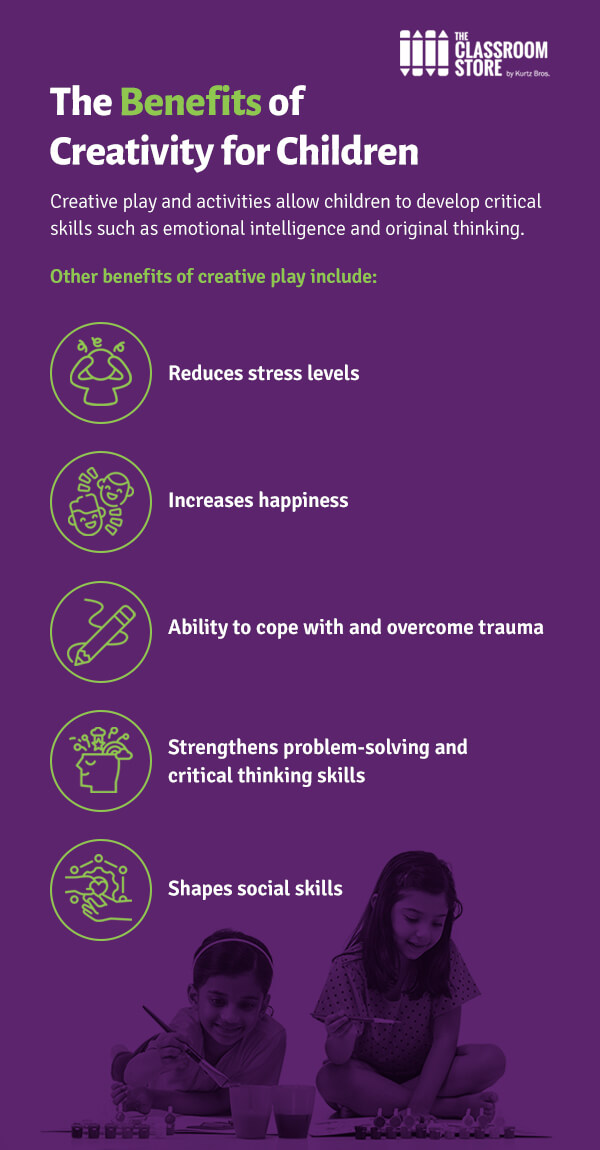Engaging and Creative Classroom Activities for Kids

When a student insists on you seeing their newest drawing or reading the poems they have been working on, they are sharing more than just their art. Creative activities allow students to express themselves in ways they may be unable to otherwise.
Creative activities also give teachers a better look into their students’ hearts and minds, allowing for a better teacher-student connection. Additionally, encouraging creativity in the classroom will enable students to express themselves and try new things in a safe space.
Bring fun into the classroom while also teaching skills students will continue to use as they grow by incorporating creativity-building activities into your classroom curriculum.
The Benefits of Creativity for Children
Creative play and activities allow children to develop critical skills such as emotional intelligence and original thinking. Imaginative play is also key in developing a child’s mental growth and emotional health. Other benefits of creative play include:
- Reduces stress levels: Creative play, especially when a trusted adult engages in the activity, releases a child’s endorphins that allow them to destress and feel happy. Yes, children feel stress too. Creative play can teach children how to relieve stress in a healthy way. Teaching healthy mental health habits to children while they are young can help them face adversity later in life.
- Increases happiness: Research shows that children’s moods increased significantly after drawing. In one study, school-aged children were asked to think about something sad before drawing. After their drawing session, the children’s moods were again evaluated. The study concluded that the creative outlet of drawing helped make the children feel happier and overall acted as an emotion regulation tool. Engaging in creative activities allows children to displace any negative thoughts with positive ones.
- Ability to cope with and overcome trauma: When children face traumatic events, they may not be able to express or even fully understand their feelings. Using creative outlets such as drawing, sculpting, painting or writing allows children to begin to process their emotions and enables adults to better understand what is going through the child’s mind to help them. For example, children impacted by Hurricane Katrina and the Oso, Washington landslide used creative activities and expression to help them understand and cope with the trauma they had endured.
- Strengthens problem-solving and critical thinking skills: Creative play and activities allow kids to try new things and experiment with problem-solving techniques without judgment. Creative play means there’s no right or wrong way to do something, so kids can feel safe and comfortable working through these skills. What kids learn in imaginative play can then be applied to other areas of their lives, such as schoolwork and social interactions.
- Shapes social skills: Creativity-building activities teach children that there is typically more than one right way to do something. Seeing how their peers create the same thing but in a different way encourages children to accept different opinions and become tolerant of ideas and ways of thinking that differ from their own. Children can also learn the value of collaboration and how working together can create new ideas.
Creativity is so much more than just creating art. When strengthened, it is a skill that can help children navigate life. Adults still use creative thinking to solve problems at work, decorate their homes, plan events and more. Therefore, teaching and developing students’ creativity deserves a place in the classroom to help students thrive now and in the future.
10 Activities That Promote Creativity in the Classroom
There are many ways to encourage creativity in the classroom. Below is a list of creativity-building activities that can help you get started with strengthening your student’s creative skills in the classroom. Some of the following activities may require individual modification to better include students with limited mobility or other disabilities.
Journaling or Free Write Sessions
Writing is an excellent way for children to express their emotions and build creativity. Consider starting class sessions with free write sessions where students can express anything they need to. This may come in the form of personal journaling, fictional short stories or poems.
Free write sessions can be set up to give students free rein to write about anything they would like, or they can be guided. Guided free write sessions give students a prompt and allow them to answer or follow the prompt however they see fit.
One prompt may be “write about something exciting that will happen in the future.” One student may use this prompt to write about an event they have coming up that they are excited about. Another student may write about where they see themselves as an adult. A different student may use this prompt as inspiration to write a short fictional story about flying cars they hope will exist in the future.
Other writing prompt examples include:
- What is something that makes you happy?
- Write about your favorite place to visit.
- Write about your favorite animal.
- What do you like most about school?
- Which holiday is the most fun and why?
- Write about something you think is funny.
Depending on the age of your students, your prompts may become more specific or thought-provoking. It is up to your discretion if you would like to collect students’ writings or allow them to write for their own enjoyment or expression.
Role-Play and Imaginative Play
Role-playing or imaginative play is a fun way to get students to collaborate and express their creativity with their peers. Role-playing also teaches kids how to put themselves in someone else’s shoes and imagine how another person feels. This can help build kids’ compassion for others.
Like a free write session, imaginative play can be child-led or teacher-led. Child-led imaginative play gives students the freedom to be whoever they want in whatever situation they want. A teacher-led imaginative play session is a guided session where roles or parts can be assigned.
If you teach students who can read, divide the class into a few small groups and give each group a short skit to practice performing. At the end of the week, allow them to perform for one another — foster their creativity by providing costumes and props for students to use during their role-playing.
Nature Art
Teach students to use items in new ways by turning leaves and sticks into art projects. Allow students to explore outside and collect anything they find beautiful, weird or useful for an art project.
Grass can become hair, a leaf can become a dress and a stick can become a magic wand. Once students collect their nature items, allow them to glue their items onto cardstock paper to create a collage, portrait or anything else they can imagine.
Once the art projects are complete, encourage students to share their artwork with their peers. This will allow them to see how others view the same objects and how everyone’s creativity differs. One student may use a flower as the sun, while another uses it as a hair bow. Showing the endless possibilities of what one object can be can encourage students to keep using their imagination.

Build With Blocks or Other Materials
When thinking of activities to build creativity in students, you may need to remember to consider something as simple as building with blocks. Creativity is often equated to art, but building activities can be creative too.
Students develop fine motor skills and creativity through building with different materials. Classic block sets allow students to construct simplistic shapes in various sizes and colors. For older or more advanced children, try more complex building sets like this Mosaic Art 3D set or the Constructa Den set that allows students to build a house, boat or other hideaways they can play in after building.
Make Music
Making music can be as simple as making different beats using classroom objects like pencils and a desk. Try Challenging students to create a song that includes information from a current lesson. This musical activity allows students to get creative while reinforcing the current lesson’s main ideas.
If you’ve noticed students struggling with a specific concept or lesson, give this activity a try. When students get creative in writing their songs, they begin to look at the information in a new way and can begin to move past any learning blocks.
Song-making activities can be done together as a whole classroom, in groups or pairs or individually.
Egg Drop Challenge
This activity most likely isn’t the first to come to mind when thinking of ways to develop student’s creativity, but it is actually a great creative challenge for your students. Most students will engage in making art or playing pretend at home, but it is rare for kids to have experienced purposely trying to drop an egg without it breaking!
For the egg drop activity, split students up into groups. Provide them with a variety of materials — this egg drop kit is a great place to start — and instruct them to build a “home” for the egg that will protect it from breaking when it drops. Students will have to be collaborative and get creative to construct their protective home.
Creativity and logic will need to be used together during this activity, modeling to students that creativity can help them problem-solve a variety of situations.
Create Videos
As technology becomes increasingly integrated into our everyday lives, it’s beneficial for students to see how they can be creative with technology. Filming a video, even if it is only a minute or two long, requires students to combine other creativity-building activities such as role-playing for acting, building and painting to create props or sets and writing to create a script.
Your students may know even more about technology than you do, so let them take creative control when it comes to adding virtual effects or editing the recording. For older-aged children, allow their creativity to have no limits and use a green screen to make their productions more professional and fun!
Some creative ideas for making videos include:
- Allowing students to write their own short films.
- Making a movie trailer for a book the class just read.
- Creating an informational video on a critical moment from history.
- Filming a classroom tour where students explain how each part of the room is used in their own words.
- Developing a video yearbook where each student can introduce themselves and state a fun fact or two.

Sculpt With Play Dough
Sculpting may sound like an intricate art form, but it doesn’t have to be. Introduce your students to sculpting through play dough or modeling clay. This is a great activity to utilize during any free time throughout the day.
Depending on your student’s age, you may see varying levels of creativity. Younger kids may opt to make simple shapes or just enjoy playing with the texture of the materials, while older kids may sculpt more complex figures, such as people and animals.
Play dough and clay can also be great tools to use with students with sensory sensitivities. Using play dough tools like rollers and plastic clay cutters can make this activity more inclusive and appealing to students who may be overwhelmed by the sensation of using their hands to play with the clay.
Finger Paint
Finger painting can get a little messy, so it may not be an activity you want to use every week, but it is still a worthwhile activity to incorporate into the classroom when you can.
All this activity requires is some paper, skin-safe washable paint and creative hands and minds. Students can express their creativity while having fun getting their hands a little messy. Avoid having too much mess by laying down newspaper over students’ desks or tables, or provide each student with a plastic activity tray to catch any dripping or runaway paint.
Make Puppets
Use socks, gloves or any other available fabric, and have students create their own puppet. This activity makes students look at things in a different way. They will have to get extra creative to figure out how to turn their old sock into a beautiful princess or scary dragon.
Consider incorporating this activity into an Earth Day lesson to demonstrate to students that old products can have a new life if you get creative.
If your students are feeling extra creative, allow them to use their art skills to make backdrops and props for their sock puppets and let them put on a show. Another option is to assign each student a character from the book the class is currently reading and see how different students imagine different characters.
Find Supplies for Your Creative Activities at The Classroom Store
Whether you’re looking for costumes, props, paint or glue, find the supplies you need to take your creativity-building activities to the next level by shopping online at The Classroom Store. From the very beginning, we’ve believed in providing a safe, productive and fun learning environment, so we’re here to provide you with the best tools to help foster creativity within your classroom.
It’s clear providing creative outlets to students is a valuable and worthwhile effort. Try some of our creative activities for kids or create your own and shop our classroom materials today!



